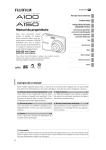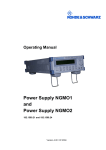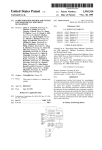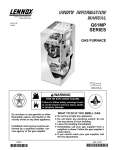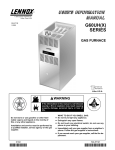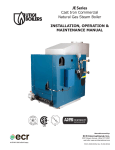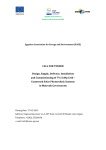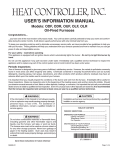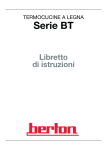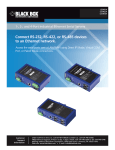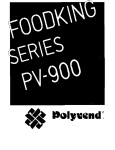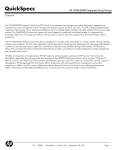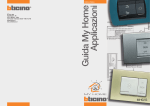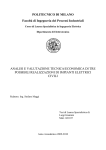Download G34E User Manual_Nov 2003
Transcript
USER’S MANUAL G34E/G34EV EXTERNAL SERIES GAS FURNACE GAS FURNACES – 50 Hz G34E/G34EV NOVEMBER 2003 USER’S INFORMATION MANUAL **INSTALLER – AFFIX THIS INSTRUCTION PACKET ADJACENT TO THE FURNACE. **HOMEOWNER – RETAIN THESE INSTRUCTIONS FOR FUTURE REFERENCE. LENNOX HEATING & AIR CONDITIONING - DIVISION OF HEATCRAFT AUSTRALIA PTY LTD Note: Due to an ongoing commitment to quality and design improvements, specifications, ratings and dimensions are subject to change without notice and without liability - Heatcraft Australia Pty Ltd, 2003 Owner Record Furnace Model # Serial # Installation Date INSTALLED BY: Dealer Address Telephone # Licence # Contact Person Other Equipment Installed: Equipment Type Installation Date Model # Serial # Equipment Type Installation Date Model # Serial # Equipment Type Installation Date Model # Serial # USER’S INFORMATION MANUAL Gas-Fired Furnace READ ALL INSTRUCTIONS IN THIS MANUAL AND RETAIN THIS AND ALL ADDITIONAL INSTRUCTIONS FOR FUTURE REFERENCE. Congratulations... ...you have one of the most modern gas furnaces made. Your unit has been carefully selected to keep you warm and comfortable during the winter months. It will deliver superb performance with only minimal help from you. To keep your operating costs low and to eliminate unnecessary service calls, we have provided a few guidelines. These guidelines will help you understand how your gas furnace operates and how to maintain it so you can get years of safe and dependable service. FIRE OR EXPLOSION HAZARD Failure to follow safety warnings exactly could result in serious injury death or property damage. - Do not store or use gasoline or other flammable vapors and liquids in the vicinity of this or any other appliance. - What to do if you smell gas: • Do not try to light any appliance. • Do not touch any electrical switch; do not use any phone in your building. • Leave the building immediately. • Immediately call your gas supplier from a neighbor’s phone. Follow the gas supplier’s instructions. • If you cannot reach your gas supplier, call the fire department. - Installation and service must be performed by a qualified installer, service agency or the gas supplier. TABLE OF CONTENTS SAFETY ...................................................................................................................................................................... 2 OPERATING YOUR FURNACE ................................................................................................................................ 2 Lighting Instructions ...................................................................................................................................................... 2 Temperature Control ...................................................................................................................................................... 3 Fan Operation ................................................................................................................................................................ 3 MAINTENANCE OF YOUR FURNACE ...................................................................................................................... 4 Periodic Inspections ...................................................................................................................................................... 4 Cleaning/Replacing the Filter ........................................................................................................................................ 5 Parts Replacement Guide ............................................................................................................................................ 6 20541401 Issue 0230 Page 1 of 6 For your safety Read before operating A flood-damaged furnace is extremely dangerous. Attempts to use the furnace can result in fire or explosion. A qualified service agency should be contacted to inspect the furnace and to replace all gas controls, control system parts, electrical parts that have been wet or the furnace if deemed necessary. Here are a few “Do’s and Don’ts” • Do become familiar with the instructions. • Do check to see that your home has adequate insulation, weatherstripping, caulking, and storm windows. Elimination of infiltration of outside air and drafts can save up to 40% of your fuel bill. • Do consider adding a humidifier to your heating system. Higher indoor humidity slows evaporation of perspiration, making the home seem warmer. • Don’t waste fuel by setting your thermostat too high. Energy conservation experts recommend a daytime thermostat setting of 20°C, with a lower setting at night. • • Do lower the thermostat setting a few degrees if you expect to be away for more than a day. Your normal temperature setting can then be restored more economically. Don’t turn off the furnace when you expect to be away for more than a day. Instead, lower the thermostat setting a few degrees. You can then restore normal comfort level quickly and save fuel too. The furnace area must be kept clear and free of combustible materials, gasoline, and other flammable vapors and liquids. Failure to do so could cause actions that may result in property damage, personal injury, or loss of life. Operating Your Furnace Lighting Instructions 1. STOP! Read the previous safety information. 2. Set the thermostat to the lowest setting. 3. Turn off all electric power to the furnace. 4. Remove the burner compartment access panel. 5. This appliance is equipped with an automatic ignition. device. Do not try to light the burners by hand. 6. Move the gas control switch to “OFF” (see Figure 1). Figure 1 Gas Control Diagram • Don’t block registers with furniture. • Don’t put a lamp, TV, or radio too near your thermostat. This will cause it to give a false reading. If you do not follow these instructions exactly, a fire or explosion may result, causing property damage, personal injury, or loss of life. These furnaces are equipped with an ignition device which automatically lights the burners. Do not try to light the burners by hand. 7. Wait 5 minutes to clear out any gas. Then smell for gas (including at the bottom of the unit near the ground). If you smell gas, stop and follow the directions in “What to do if you smell gas” on page 1. If you don’t smell gas, continue to next step. If the switch will not move by hand, don’t try to repair it, call a qualified service technician. Force or attempted repair may result in a fire or explosion. 8. Move the gas control switch to “ON”. Do not use this furnace if any part has been under water. 10.Turn on all electric power to the furnace. 20541401 9. Replace the burner compartment access panel. Issue 0230 Page 2 of 6 11. Set the thermostat to the desired setting. Fan Operation 12.If the furnace will not operate, follow the instructions in “To Turn Off Gas to Furnace” and call your service technician or gas supplier. You may wish to increase your comfort by setting your system for continuous air circulation of the indoor air. The fan switch on the thermostat permits you to do this. To Turn Off Gas to Furnace With the switch in the “ON” position the fan will operate continuously. “AUTO” position gives fan operation only when the unit is in either heating or cooling. 1. Set the thermostat to the lowest setting. 2. Turn off all electric power to the furnace if service is to be performed. 3. Remove the burner compartment access panel. 4. Move the gas control switch to “OFF” (see Figure 1). Do not force. 5. Replace the burner compartment access panel. What to do if your unit is not heating properly If your furnace is operating but fails to provide complete comfort, check the following before calling for service: 1. Be sure the thermostat setting is correct. 2. Check to see if the filter is clean. 3. Check with the contractor for return air grille locations. Temperature Control There are many types and styles of thermostats. Yours may look different from the one pictured in Figure 2, depending on the type of thermostat and whether cooling was installed with the system. However, almost all thermostats perform the same basic functions described in the following section. 4. Be sure air can circulate freely throughout your home. Do not block supply registers or return air grilles with furniture or rugs. And if you also have cooling... 5. Keep surface of the outdoor coil free from dirt, lint, paper, or leaves. 6. Check and clean indoor coil, if necessary. (This check should be made at the start of each cooling season by your service technician). What to do if your unit fails to operate 1. Be sure the main switch that supplies power to the furnace is in the “ON” position. 2. Replace any burned-out fuses or reset circuit breakers. 3. Be sure the thermostat is properly set. Figure 2 4. If the furnace still does not start, call your service technician. Thermostat Operation There are two (2) switches located on the thermostat (see Figure 2). One switch controls the heating and cooling (if applicable) functions. The other switch is for “FAN” operation, either continuous or automatic. On the thermostat is the temperature range for the heating temperature and the cooling temperature desired. Should the gas supply fail to shut off or if overheating occurs, shut off the gas valve to the furnace before shutting off the electrical supply. To put the system into operation, push the switch to either “HEAT” or “COOL” position. After you have chosen the type of operation you desire, move the thermostat dial or lever to select the temperature you would like the system to maintain. 20541401 Issue 0230 Page 3 of 6 Maintenance Of Your Furnace Should you observe unusual amounts of any of the following conditions, it is important that you call your authorized dealer at once to obtain a qualified service Always shut off all power to the unit before attempting any of the following maintenance procedures. Failure to do so may result in personal injury. inspection: • Rust, flakes, or other deposits • Coatings There are routine maintenance steps you should take to keep your furnace operating efficiently. This maintenance will assure longer life, lower operating costs, and fewer service calls. In addition to the maintenance procedures listed in this manual, there are also other service and maintenance procedures that require the skills of a service person who has specialized tools and training. (See “Servicing the Furnace” section of the Installation and Servicing part of this booklet.) Personal injury can result if you are not qualified to do this work. Please call your dealer when service is needed. • Corrosion Even if no unusual rust or other conditions are observed, it is recommended that the furnace be inspected and serviced at least once per year by a qualified service technician. Regular inspection and planned maintenance will assure many years of economical performance from your gas furnace. Combustion Air Cleaning Adequate combustion and ventilation air must reach your gas furnace to provide for proper and safe operation. Do not block or obstruct air openings on the furnace, air openings communicating with the area in which the furnace is installed and the spacing around the furnace. Any obstruction of this airflow can cause an unsafe condition which may result in death or permanent injury. The cabinet of the furnace can be cleaned with soap and water. Grease spots can be removed with a household cleaning agent. The cabinet can be kept attractive by polishing with automotive wax at least twice a year. Installations Around Insulation Insulating materials may be combustible. Therefore, a furnace installed in an attic or other insulated space must be kept free and clear of insulating materials. Make sure to examine the furnace area when the furnace is installed or additional insulation has been added. Furnaces located in a closet, alcove, or utility room must have provision for adequate air supply by means of upper Periodic Inspections and lower grilles in the door, or by the introduction of Your gas furnace is designed to give many years of efficient, satisfactory service. However, the varied air pollutants commonly found in most areas can affect longevity and safety. Chemicals contained in everyday household items such as laundry detergents, cleaning sprays, hair sprays, deodorizers, and other products which produce airborne residuals may have an adverse affect upon the metals used to construct your appliance. It is important that you conduct periodic physical inspections of your appliance, paying special attention to the gas burner and the flue outlet from the furnace. These components are located at the front of the unit. A flashlight will be useful for these inspections. Make one inspection prior to the beginning of the heating season and another during the middle. outside air, or both. AGA codes must be adhered to. Flueing and Furnace Support Flueing of this furnace must comply with our published instructions. Be sure the installer has followed these requirements. If not, you should request the installer to comply as soon as possible. For your safety, please note the following: 1. Non-condensing furnaces may be common vented with another appliance in certain circumstances. Refer to the installation instructions. Refer to the installation instructions and AGA 601 code for proper installation guidelines. 20541401 Issue 0230 Page 4 of 6 The vent from your furnace may rise vertically and terminate above the roof. When horizontal flueing a noncondensing furnace, an approved flue cowl must be used. Refer to the installation instructions for further information on horizontal flueing. Make sure all flue product carrying areas and materials external to the furnace (i.e. vent terminals, etc..) are clear and free of any obstruction, slope upward, and have no holes or leaks. Refer to Table 1 when selecting the proper size and quantity of disposable filter. If your air distribution system has a central return air filtergrille, you do not need a filter in your furnace. Clean the filter-grille the same way permanent filters are cleaned. Table 1 EXTERNAL FILTER RACK SIZE Check to see that the furnace cabinet is sound and firmly supported, without sagging. There should be no cracks or gaps between the furnace and the base or floor, which would permit entry of unfiltered air. It is important that the outside area where the vent terminates is kept clear of any obstructions which might block or impede the venting of the furnace. Should venting become blocked at anytime, your furnace is equipped with a special safety control to prevent operation of the furnace until the condition has been corrected. Contact your dealer if you desire more information about this safety feature. Should any unusual conditions be observed during your inspections, call an authorized service dealer immediately. SIDE RETURN 394 X 635 394 X 635 394 X 635 BOTTOM/END RETURN 305 X 635 394 X 635 483 X 635 Note: Filters not supplied Safety Interlock Switch The blower compartment door on your furnace is equipped with a safety interlock switch that will automatically shut off your complete system (including blower) once the door is removed. This is for your personal safety. Be sure to check your furnace for proper operation once the door or panel has been replaced. For proper venting terminations, see the Installation Instructions furnished with the furnace. If the system does not operate once the panel has been replaced, try removing and replacing it once again. If the furnace still does not operate, call your dealer for service. Return Air Rollout Switch Ascertain that all return air duct connections are tight and sealed to the furnace cabinet and that all return air grilles or registers are located outside the space containing the furnace. This unit is equipped with a manual reset high temperature sensor or rollout switch. In the unlikely event of a sustained main burner flame rollout, the rollout switch will shut off the flow of gas by closing the main gas valve. The switch is located inside the gas burner area. Flame rollout can be caused by blockage of the power vent system, a blocked heat exchanger, or improper gas pressure or adjustment. If this event occurs, the unit will not operate properly. The gas supply to the unit should be shut off and no attempt should be made to place it in operation. The system should be inspected by a qualified service technician. Cleaning/Replacing the Filter It is very important to clean or replace the air filter regularly. Dirty filters are the most common cause of inadequate heating or cooling performance and can sharply increase the operational costs of your unit. In some cases, they can double the cost. The air filter should be inspected at least every 6 weeks and cleaned or replaced as required. Your furnace may use either a disposable filter or a permanent filter. The type of filter may be indicated on a label attached to the filter. If a disposable filter is used, replace with the same type and size. If a permanent filter is used, clean filter and place back in furnace. To clean a permanent filter, shake filter to remove excess dirt and/or use a vacuum cleaner. Wash filter in soap or detergent water and replace after filter is dry. Permanent filters do not need to be oiled after washing. Permanent filters may be replaced with disposable filters. 20541401 Lubrication Lubrication of the bearings in the circulating air blower motor and the combustion blower motor is not recommended. Burner Flame While the furnace is in operation, observe the mainburner flames. Compare these observations to Figure 3 to determine if proper flame adjustment is present. If your observations indicate improper flame adjustment, call your authorized service dealer for service. Issue 0230 Page 5 of 6 Warranty Procedure When warranty parts are required: 1. Be prepared to furnish the following information: a. Purchaser’s name b. Complete model number, serial number, and date of installation. c. An accurate description of the problem or defective parts. 2. Contact your dealer or distributor. Keep this User’s Information Manual (including Warranty) and proof of purchase for your records. Your warranty is determined from your date of installation. If proof of your date of installation is not supplied, the warranty will be based on the manufacture date code. Figure 3 Do not attempt to adjust flame! Your service representative will perform this adjustment correctly. Failure to follow the correct warranty procedure could result in disallowance of warranty claim. PARTS REPLACEMENT INFORMATION GUIDE CASING GROUP GAS CONTROL GROUP BLOWER GROUP Top Panel Bottom Panel Cabinet Wrapper Partition Front Door Blower Door Manifold Burner Orifice Gas Control Sensor Ignitor Shield Top & Bottom Blower Assembly Blower Housing Blower Motor Blower Wheel Capacitor Blower Cutoff Blower Support ELECTRICAL GROUP HEAT EXCHANGER GROUP INDUCER GROUP Control Box Limit Switch Fan Timer Control Board Rollout Switch Transformer Primary Heat Exchanger Flue Box Inducer Burner Opening Panel Burner Inlet Plate Flue Opening Pane Pressure Switch Blower & Motor Inducer Adapter Plate TO OBTAIN INFORMATION ON PARTS: Consult your installing dealer or classified section of your local telephone directory under the “Heating Equipment” or “Air Conditioning Contractors & Systems” headings for dealer listing or see the first page of the installation instruction section of this manual for the name and address to contact. Have available the Model No. and Serial No. located on the unit rating label located on the furnace to insure correct replacement part. WARNING: Improper installation, adjustment, alteration, service or maintenance can cause personal injury or property damage. Consult a qualified installer, service agency, or your local gas supplier for information or assistance. 20541401 Issue 0230 Page 6 of 6 G34E/G34EV EXTERNAL SERIES GAS FURNACES AFFIX LABEL HERE INSTALLATION AND SERVICING INSTRUCTIONS TABLE OF CONTENTS Safety ........................................................................................1 Electrical....................................................................................8 Furnace Specifications ..............................................................2 Wiring Diagram........................................................................10 Installation Equipment ..............................................................3 Unit Start Up ............................................................................11 Duct System ..............................................................................4 Unit Adjustments ....................................................................13 Installing Optional Cooling Coil ................................................4 Service Procedures ................................................................14 Venting & Flueing ......................................................................5 Parts Listings ..........................................................................16 Setting up Procedures ..............................................................6 Coil Fitting Instructions............................................................18 Gas Piping ................................................................................7 Trouble Shooting ....................................................................19 RETAIN THESE INSTRUCTIONS FOR FUTURE REFERENCE Do not store or use petrol or other flammable vapors and liquids in the vicinity of this or any other appliance. Installation and service must be performed by a qualified installer, service agency or the gas supplier to AGA 601 installation codes. Installation by an unqualified person may lead to equipment damage and/or a hazardous condition which may cause bodily injury and harm and, as such, at the sole discretion of the manufacturer, the entire warranty may be voided and be of no further force and effect. WHAT TO DO IF YOU SMELL GAS: • Do not try to light any appliance. • Extinguish any open flame. • Do not touch any electrical switch; do not use any phone in your building. • Immediately call your gas supplier from a neighbour’s phone. Follow the gas supplier’s instructions. • If you cannot reach your gas supplier, call the fire department. Page 1 of 26 SAFETY The following is a list of safety precautions and their locations in this manual. These safety rules and precautions must be followed when installing this furnace. 1. Use only with type of gas approved for this furnace. Refer to the furnace rating plate. 2. Install this furnace only in a location and position as specified in The Location/Placement Section on page 4 of these instructions. 3. Never test for gas leaks with an open flame. Use a commercially available soap solution made specifically for the detection of leaks to check all connections, as specified in the Gas Piping section on page 7 of these instructions. 4. Always install furnace to operate within the furnace’s intended temperature-rise range with a duct system which has an external static pressure within the allowable range, as specified in Furnace Specifications on page 3 of these instructions. See furnace rating plate. 5. The furnace is not to be used for temporary heating of buildings or structures under construction. Page 2 of 26 G34E/EV FURNACE SPECIFICATIONS DIMENSIONS mm MODEL A B C D E F G H I J K G34E/EVQ3-80 443 1023 1345 259 803 259 803 426 – 305 231 G34E/EVQ4-80 443 1023 1345 259 803 259 803 426 – 305 231 G34E/EVQ4-110 529 1060 1485 425 898 308 898 426 444 356 231 G34E/EVQ5-110 529 1060 1485 425 898 308 898 426 444 356 231 G34E/EVQ5-130 529 1060 1502 425 955 357 946 427 451 356 231 OPTIONAL DUCT FLASHING KIT FITS EITHER SIDE PART #700960 FLUE TERMINAL C FLUE TERMINAL REFRIGERATION ACCESS PLATE 050/080/110/130 & CONDENSATE DRAIN CONNECTIONS 150 ACCESS HATCHES B H H RETURN AIR SUPPLY AIR I BACK VIEW 050/080=90 110/130=130 LEFT SIDE (VIEWED FROM FRONT) FLUE TERMINAL F 050/080=35 L10/130=45 G FLUE TERMINAL REGISTRATION ACCESS PLATE L10/L30 & CONDENSATE DRAIN CONNECTIONS SERVICE COVER DUCT CONNECTIONS ELECTRICAL INLETS GAS CONNECTION 3/4" J J RETURN AIR SUPPLY AIR K FRONT VIEW D E NOTE: DUCT CONNECTIONS AND ACCESS HATCHES ARE INTERCHANGEABLE FROM SIDE TO SIDE Page 3 of 26 16 FURNACE BLOWER SPECIFICATIONS AND AIR FLOW DATA BLOWER SYSTEM BLOWER SPEED 0.1 / 25 0.2 / 50 0.3 / 75 EXTERNAL STATIC (IN. W.C.) / pa 0.4 / 100 0.5 / 125 0.6 / 150 0.7 / 175 0.8 / 200 0.9 / 225 1.0 / 250 G34E/EVQ3-50 LOW 390 366 343 320 295 270 241 214 185 157 (254 X 152 WHEEL) MED 552 529 503 476 448 418 386 353 318 281 (1/3HP MOTOR) HIGH 698 674 648 619 589 558 525 490 454 416 G34E/EVQ3-80 LOW 390 366 343 320 295 270 241 214 185 157 (254 X 152 WHEEL) MED 552 529 503 476 448 418 386 353 318 281 (1/3HP MOTOR) HIGH 698 674 648 619 589 558 525 490 454 416 G34E/EVQ4-80 LOW 612 603 593 582 570 556 541 526 509 491 (305 X 228 WHEEL) MED 772 764 755 744 733 720 706 691 675 658 (1HP MOTOR) HIGH 951 931 908 884 857 828 797 764 728 690 G34E/EVQ4-110 LOW 612 603 593 582 570 556 541 526 509 491 (305 X 228 WHEEL) MED 772 764 755 744 733 720 706 691 675 658 (1HP MOTOR) HIGH 951 931 908 884 857 828 797 764 728 690 G34E/EVQ5-110 LOW 794 761 725 687 646 604 558 510 459 406 (305 X 305 WHEEL) MED 982 945 908 875 846 818 794 773 754 738 (1HP MOTOR) HIGH 1204 1178 1152 1126 1100 1075 1050 1025 1000 976 G34E/EVQ5-130 LOW 794 761 725 687 646 604 558 510 459 406 (305 X 305 WHEEL) MED 982 945 908 875 846 818 794 773 754 738 (1HP MOTOR) HIGH 1204 1178 1152 1126 1100 1075 1050 1025 1000 976 NOTES: 1. Air flow values in (L/s). 2. Data taken without filters in place or A/C evaporator in place. When operating the furnace in the heating mode, the static pressure and the temperature rise (supply air temperature minus return air temperature) must be within those limits specified on the rating label. Failure to follow this warning could lead to severe furnace damage. Turn OFF all gas and electrical power to furnace before performing any maintenance or service on unit. (Unless specific test requires gas and electrical supplies.) Failure to take this precaution may result in personal injury due to electrical shock or uncontrolled gas leakage. Page 4 of 26 SHIPPING AND PACKING LIST Package 1 of 1 contains: 1 - Assembled unit 1 - Flue adapter/cowl field–installed 2 – Starting collars The following additional items may be ordered separately, if required: 1 - Cooling coil 1 - Thermostat 1 - LP Changeover kit Check unit for shipping damage. Receiving party should contact last carrier immediately if any shipping damage is found. GENERAL DUCT SYSTEM These instructions are intended as a general guide and do not supersede local codes in any way. Consult AGA. AG-601 INSTALLATION CODE or authorities having jurisdiction before installation. The unit is provided with knockouts for either right or left-side connection of the supply and return air plenums. Refer to the dimensioned drawing on page 2 to locate and size the plenum entry into the side of the building. Cover plates are provided to seal the unused knockouts and these become convenient access ports for regular service and maintenance. The G34E-EV furnace is approved for installation outside the building only with clearances as listed in figure 1. Installation of Lennox outdoor central furnaces must be in accordance with these instructions, local gas fitting regulations, municipal building codes, electrical wiring regulations and the current edition of the Australian Gas Installation Code (AG 601) The following general recommendations should be considered when installing the Lennox G34E-EV furnace. LOCATION / PLACEMENT The Lennox G34E/EV can be installed in either right or left hand mode. NOTE – On some models - 1/3 and 1/2 hp blower motors are equipped with either four flexible mounting legs or three flexible legs and one rigid leg. The rigid leg is equipped with a shipping bolt and a flat white plastic washer (rather than the rubber mounting grommet used with a flexible mounting leg). This shipping bolt and flat washer must be removed before the furnace is put into operation. Once the shipping bolt and washer are removed, the rigid leg will not touch the fan housing. Select a unit location that will allow for required clearances per local AG 601 codes and in figure 1. Also consider gas supply connections, electrical supply, vent termination and installation and service clearances (600mm. front). Accessibility and service clearances must not take precedence over fire protection clearances. The Lennox G34E-EV furnace should be set on a field-provided platform to keep the unit base out of water. The unit is equipped with base rails, which lift the bottom of the unit off of the platform. Unit must be leveled using shims or leveling bolts. Knockouts are provided in unit base to install field-provided leveling bolts. Page 5 of 26 Size and install supply and return air duct system using industry-approved standards that result in a quiet and low-static system with uniform air distribution. The furnace access panel must always be in place when the unit is in operation and it must not allow leaks into the duct system. Construct a protective covering made of suitable materials to shield the plenum connections from rain. Rain shield should be attached to the side of the unit cabinet above the plenum connections and span the distance to the building wall above the plenum entry into the structure. Rain shield connections must be caulked so that they are weather-tight. INSTALLING OPTIONAL COOLING COIL If optional cooling coil is to be used, install coil according to the steps indicated below: 1 - Remove G34E-EV unit rear panel (side panel on G34E-EV130). NOTE - Installation of larger evaporator coils may require removal of unit top panel as well. 2 - Place cooling coil on unit coil deck in cooling compartment. 3 - Using template provided with the coil, cut holes for refrigeration and drain piping. Align coil with piping holes in panel. Seal holes around piping. 4 - Reinstall G34E-EV panel. 5 - Make refrigerant piping connections to condensing unit per local codes and sound plumbing practices. VENTING The G34E unit is shipped standard for top flue discharge. A flue adapter is supplied with the furnace. It must be installed on the outside of the furnace. Figure 1 FLUE TERMINATION CLEARANCES a j h j n T c j openable window e e d h k P door g c I d T b g k T = Flue terminal I = Mechanical air inlet Ref. A T M f furnace M = Gas meter P = Electricity meter or fuse box Shading Indicates prohibited areas for flue termination Minimum clearances mm Natural draft Fan assisted Item Below eaves, balconies and other projections: • Appliances up to 50 Mj/h input • Appliances over 50 Mj/h input • 300 500 200 300 300 300 500 300 B From the ground, above a balcony or other surface C From a return wall or external corner D From a gas meter (M) (see 4.7.11 for vent terminal location of regulator) 1000 1000 E From an electricity meter or fuse box (P) 500 500 F From a drain pipe or soil pipe 150 75 G • or obstruction facing a terminal From any other flue terminal, cowl, or combustion air intake • 500 500 500 300 500 1500 1500 300 500 1500 1500 H J • Horizontally from any building structure Horizontally from an openable window, door, non-mechanical air inlet, or any other opening into abuilding with the exception of sub-floor ventilation: • Appliances up to 150 Mj/h input • Appliances over 150 Mj/h input up to 200 Mj/h input • Appliances over 200 Mj/h input • All fan-assisted flue appliances, in the direction of discharge K From a mechanical air inlet, including a spa blower 1500 1000 N Vertically below an openable window, non-mechanical air inlet, or any other opening into a building with the exception of sub-floor ventilation: • Space heaters up to 50 Mj/h input • Other appliances up to 50 Mj/h input • Appliances over 50 Mj/h input and up to 150 Mj/h input • Appliances over 150Mj/h input 150 500 1000 1500 150 500 1000 1500 • Unless appliance is approved for closer installation NOTES: 1 2 3 4 5 All distances are measured to the nearest part of the terminal. Prohibited area below electricity meter or fuse box extends to ground level. See Clause 5.13.6.6 for restrictions on a flue terminal under a covered area. See Appendix J, Figures J2(a) and J3(a), for clearances required from a flue terminal to an LP Gas cylinder. A flue terminal is considered to be a source of ignition. For appliances not addressed above, approval shall be obtained from the Authority. Page 6 of 26 GENERAL G34E & EV SERIES THERMOSTAT INSTALLATION Install a room thermostat according to the instructions furnished with it. Select a location on an inside wall and not subject to drafts, direct sunshine or other heat sources. The initial heat anticipator setting should be equal to the total current draw of the control circuit. Low voltage thermostat connections are to be made as indicated on the furnace 2 STAGE wiring diagram. FURNACE CHECK-OUT Before leaving, the installer should make the following checks to ensure that the controls are functioning properly. CHECKING AND ADJUSTING GAS INPUT The minimum permissible gas supply pressure for the purpose of input adjustment is 5 in. W.C. (1.25 kPa) for natural gas, 11 in. W.C. (2.74 kPa) for propane gas. GAS PRESSURE REGULATOR Gas input must never exceed the value shown on the furnace rating plate. The furnace is equipped for rated input at manifold pressures of 1.2 in. W.C. (0.30 kPa)–1st stage–and 3.5 in. W.C. (0.87 kPa)–2nd stage–for natural gas; 3.6 in. W.C. (0.90 kPa)–1st stage–and 10.0 in. W.C. (2.49 kPa)–2nd stage–for propane gas. The manifold pressure can be measured by connecting a water manometer or gauge to the pressure tap in the downstream side of the gas valve. Only small variations in gas input may be made by adjusting the regulator. In no case should the final manifold pressure vary more than 0.3 in. W.C. (0.07 kPa) from the above specified pressures. Page 7 of 26 2-STAGE-SET-UP Turn the gas valve ON. To adjust the regulator, turn the adjusting screw on the regulator clockwise to increase pressure and input; Counter-clockwise to decrease pressure and input. There are separate adjusting screws for 1st stage (marked “LO”, on top of solenoid coil) and 2nd stage (marked “HI”, on outlet end of valve). NOTE: The pressure regulator adjustment is sensitive; one turn of the adjusting screw will result in a relatively large change in manifold pressure. If adjustments are being made for propane gas, follow this procedure: 1. Adjust high fire setting by turning hex adjustment screw full clockwise. 2. Set low fire setting by turning the low fire adjustment screw clockwise (located on top of 2nd stage coil) to desired rate. 3. Set high fire setting by turning the high fire adjustment screw counter-clockwise to 10.0 in. W.C. (2.49 kPa) manifold pressure. Important: Make sure the final high and low fire manifold pressures are within the allowable ranges specified above for the gas being used. Check the furnace rate by observing the gas meter, when available, making sure all other gas appliances are turned off. The test hand on the meter should be timed for at least one revolution. TEMPERATURE RISE Check the temperature rise and, if necessary, adjust blower speed to maintain temperature rise within the range shown on the unit rating plate. GAS PIPING GAS SUPPLY LEAK CHECK This unit is to be installed by a licensed gas plumber fully in accordance with AG601 installation regulations. After gas piping has been completed, carefully check all piping connections (factory and field) for gas leaks. Use a leak detecting solution or other preferred means. 1 - This unit is shipped standard for centre installation of gas piping. Piping can be converted for right-side connection. Simply connect gas supply to piping assembly. 2 - When connecting gas supply, factors such as length of run, number of fittings and furnace rating must be considered to avoid excessive pressure drop. Unit connection at gas manifold is 1/2 in. (12mm). Size piping according to gas regulations. 3 - Gas piping must not run in or through air ducts, clothes chutes, chimneys or gas vents, dumb waiters or elevator shafts. 4 - Piping should be sloped 6mm per 380mm upward toward the meter from the furnace. The piping must be supported at proper intervals (2M) using suitable hangers or straps 5 - In some localities, codes may require installation of a manual main shut-off valve and union (furnished by installer) external to the unit. Union must be of the ground joint type. IMPORTANT Compounds used on threaded joints of gas piping must be resistant to the actions of liquified petroleum gases. Some soaps used for leak detection are corrosive to certain metals. Carefully rinse piping thoroughly after leak test has been completed. Do not use matches, candles, flame or other sources of ignition to check for gas leaks. The furnace must be isolated from the gas supply system by closing its individual manual shut-off valve during any pressure testing of the gas supply system at pressures equal to or less than 1/2 psig (3.48 kPa). IMPORTANT When testing pressure of gas lines, gas valve must be disconnected and isolated. See figure 4. Gas valves can be damaged if subjected to more than 1/2 psig (3.48 kPa). MANUAL MAIN SHUT-OFF VALVE WILL NOT HOLD NORMAL TEST PRESSURE GAS VALVE FURNACE CAP NOTE-Installer must provide a 1/8 in. (3 mm) N.P.T. plugged tap in the field piping upstream of the gas supply connection to the unit. Tap must be accessible for test gauge connection. This requirement is negated if the gas valve in the unit is fitted with an integral pressure tapping point. Figure 4 NOTE-If emergency shutoff is required, shut off main manual gas valve and disconnect main power to unit. These devices should be properly labelled by the installer. Page 8 of 26 ELECTRICAL ELECTROSTATIC DISCHARGE (ESD) 6- Complete wiring connections to equipment using wiring diagrams provided with unit and in field wiring diagrams shown in figures 5. Use 18 gauge wire or larger for thermostat connections. 7- Electrically ground unit in accordance with local codes. 8- Three 240 volt accessory terminals are provided on the control board. Two are energized with the indoor blower and one is energized with the combustion air blower. Any accessory rated up to one amp can be connected to the accessory terminals with the neutral leg of the circuit connected to the 240 volt neutral wires. 9- This unit is equipped with an integrated control board that controls blower operation, fan off timings (EGC Board 0nly) and ignition. The board includes a terminal strip for thermostat connections and two diagnostic LEDs. See figure 6 for control board configuration. Diagnostic codes are given in a chart at the back of this manual. Precautions and Procedures Electrostatic discharge can affect electronic components. Take precautions during furnace installation and service to protect the furnace’s electronic controls. Precautions will help to avoid control exposure to electrostatic discharge by putting the furnace, the control and the technician at the same electrostatic potential. Neutralize electrostatic charge by touching hand and all tools on an unpainted unit surface, such as the gas valve or blower deck, before performing any service procedure. These units operate on 240 volt, single phase, 50 Hz electrical power. Refer to figure 5 for field wiring and figure 7 for schematic wiring diagram and troubleshooting. 1- Select circuit protection and wire size according to requirements listed on unit rating plate. 2- Snap-hole plugs are provided on both sides of cabinet to facilitate wiring. 3- Install room thermostat according to instructions provided with thermostat. 4- Install a separate disconnect switch (protected by either fuse or circuit breaker) near the unit so power can be turned off for servicing. 5- Before connecting thermostat or power wiring, check to make sure wires will be long enough to facilitate servicing at a later date. Remove blower access panel and swing panel to check wire length for access. Page 9 of 26 The red diagnostic button can be used to view the last failure code. (EGC Ignition Board Only) 10 - Refer to blower speed chart on wiring diagrams for factory set cooling, heating and continuous fan speeds. Systems using a cooling thermostat subbase may operate the blower continuously (factory set at low speed) through the thermostat “FAN ON” switch. Systems, which do not include a cooling sub-base require a toggle switch which must be wired between terminals “R” and “G” on the thermostat connection terminal strip. The blower motor will operate at the designated speed during cooling or heating demand; however, when demand is satisfied, blower speed will revert to selected continuous speed. Figure 5 Figure 6 EGC-3A INTEGRATED CONTROL BOARD HEATING SPEED TAP TERMINAL CONTINUOUS FAN TERMINAL GND DIAGNOSTIC CODE ERASE JUMPER (Remove power to control and short pins for 10 seconds to erase previous code.) COOLING SPEED TAP TERMINAL ACCESSORY TERMINALS RED DIAGNOSTIC BUTTON (Depress button and hold for display of last failure code.) L1 HEATING ACCESSORY TERMINAL NEUTRAL TERMINALS DIAGNOSTIC LEDS THERMOSTAT TERMINAL STRIP BLOWER TIME ADJUSTMENT JUMPER Page 10 of 26 Figure 7 (EGC-3 Ignition Module) KEY COMPONENT P AL ROS P1 P2 CMB W2 BI CU T1 F X PRESSURE SWITCH AUX LIMIT PRESSURE SWITCH AUX LIMIT ROLL–OUT SWITCH ROLL–OUT SWITCH PLUG 6 PIN PLUG 6 PIN SPADE CONNECTORS SPADE CONNECTORS COMBUSTIONCOMBUSTION BLOWER BLOWER 2ND STAGE HEAT TERMINAL 2ND STAGE HEAT TERMINAL BLOWER INTERLOCK BLOWER INTERLOCK CONDENSING UNIT CONDENSING UNIT TRANSFORMER TRANSFORMER LOW VOLAGE FUSE LOW VOLAGEMANUAL FUSE RESET MANUAL RESET IGN BOARD COMPONENT OR F 5A 240V T1 24V 4 P1 P R OS P2 G 5 OR AL BK OR AL P2 W P1 (1,2) 8 P2 Y 1 P1 P2 C L WH X X 9 P1 SPARK ELECTRODE GAS VALVE FLAME FLAME SENSOR M C 3 PIN PLUG AND CORD BR BR RD RD 3 P1 4 P1 GND A N 24VAC WH N E TO CONDENSOR HUM BI L1 240V 24V TO THERMOSTAT C MAY NOT BE REQUIRED P2 R 24 VAC CMB BLWR HUM GND E L1 ACC ACC 1 L1 WH ACB COOL ACB LO ACB HEAT 2 BK BLACK RED FAULT CODES LED FAULT CODES 4 FLASHES 5 FLASHES BK BL BR BLUE INDUCER INDUBLOWER BLOW OFF NO POWER STEADY OFF NOEAT POWER NORMAL OPERATION EARTBEAT CALL FOR HEAT HEARTBEAT NORMAL OPERATION ES FOR HEAT GAS VALVE LOCKOUT FAST HEARTBEAT CALL ESVALVE LOCKOUT PRESSURE SWITCH 2 FLASHES GAS 3 FLASHES PRESSURE CLOSED SWITCHOR OPEN ES HIGH LIMIT OPEN CLOSED OR OPENSENSE WITH ES FLAME BRN CAP INDOOR BLOWER MOTOR BRN WH HIGH LIMIT OPEN FLAME SENSE WITH GAS VALVE OFF BLACK BLUE BROWN GR OR RD GREEN ORANGE RED VI WH YL VIOLET WHITE YELLOW Figure 8 (U.T. Ignition Module) IGN BOARD KEY COMPONENT 24 VAC P AL ROS P1 P2 CMB W2 BI CU T1 F X PRESSURE SWITCH AUX LIMIT ROLL–OUT SWITCH PLUG 6 PIN SPADE CONNECTORS COMBUSTION BLOWER 2ND STAGE HEAT TERMINAL BLOWER INTERLOCK CONDENSING UNIT TRANSFORMER LOW VOLAGE FUSE MANUAL RESET N E AL BK P 2 P1 R OS (1,2) 1 P1 L WH P M C Page 11 of 26 W2 3 P1 RD 4 P1 TO CONDENSOR HUM BI GND A N E 24VAC WH 701081 / CMB BLWR HUM GND ACC ACC 1 L1 COOL UNUSED HEAT FAULT CODES NO POWER NORMAL OPERATION CALL FOR HEAT GAS VALVE LOCKOUT PRESSURE SWITCH CLOSED OR OPEN HIGH LIMIT OPEN FLAME SENSE WITH GAS VALVE OFF C W2 7 B 2 BK BLACK RED 4 FLASHES 5 FLASHES P2 C FLAME FLAME SENSOR WH STEADY OFF HEARTBEAT FAST HEARTBEAT 2 FLASHES 3 FLASHES P2 W SPARK ELECTRODE BR L1 LED P2 G 6 P1 700994 – 2R05665 GAS VALVE 2 STAGE H1 24V TO THERMOSTAT C MAY NOT BE REQUIRED P2 Y 240V T1 24V 3 PIN PLUG AND CORD L1 240V 5 P1 F 5A P2 R 5 W2 RELAY C 6 BLUE INDUCER BLOWER 3 INDOOR BLOWER MOTOR WH NO 4 BRN CAP 1 BRN NC 2 Figure 9 (U.T. Ignition Module) IGN BOARD KEY COMPONENT 24 VAC P AL ROS P1 P2 CMB W2 BI CU T1 F X PRESSURE SWITCH AUX LIMIT ROLL–OUT SWITCH PLUG 6 PIN SPADE CONNECTORS COMBUSTION BLOWER 2ND STAGE HEAT TERMINAL BLOWER INTERLOCK CONDENSING UNIT TRANSFORMER LOW VOLAGE FUSE MANUAL RESET N E AL P 5 P1 T1 240V 24V BK R OS (1,2) P M H1 C P2 W P2 Y 1 P1 P2 C 9 P1 W2 SPARK ELECTRODE FLAME FLAME SENSOR BR 3 P1 RD 4 P1 TO CONDENSOR HUM BI GND A N WH E GND 24VAC 701081 / CMB BLWR HUM L1 ACC ACC 1 L1 ACB COOL ACB LO FAULT CODES STEADY OFF HEARTBEAT FAST HEARTBEAT 2 FLASHES 3 FLASHES NO POWER NORMAL OPERATION CALL FOR HEAT GAS VALVE LOCKOUT PRESSURE SWITCH CLOSED OR OPEN HIGH LIMIT OPEN FLAME SENSE WITH GAS VALVE OFF C W2 7 B 2 BLACK RED LED ACB HEAT BK WH 4 FLASHES 5 FLASHES 24V TO THERMOSTAT C MAY NOT BE REQUIRED P2 G 8 L WH 700994 – 2R05665 GAS VALVE 2 STAGE 3 PIN PLUG AND CORD L1 240V 4 P1 F 5A P2 R 5 W2 RELAY C 6 BLUE INDUCER BLOWER 3 INDOOR BLOWER MOTOR NO 4 BRN CAP 1 NC 2 BRN WH UNIT START-UP FOR YOUR SAFETY READ BEFORE LIGHTING Do not use this furnace if any part has been underwater. Immediately call a qualified service technician to inspect the furnace and to replace any part of the control system and any gas control which has been under water. If overheating occurs or if gas supply fails to shut off, shut off the manual gas valve to the appliance before shutting off electrical supply. Before attempting to perform any service or maintenance, turn the electrical power to unit OFF at disconnect switch. BEFORE LIGHTING smell all around the appliance area for gas. Be sure to smell next to the floor because some gas is heavier than air and will settle on the floor. Use only your hand to turn the gas control knob. Never use tools. If the knob will not turn by hand, do not try to repair it, call a qualified service technician. Force or attempted repair may result in a fire or explosion. Page 12 of 26 UNIT START-UP (CONT.) PLACING UNIT INTO OPERATION 6- White Rodgers 36E Gas Valve - Turn knob on gas valve 180˚ either way to OFF. See figure 8. Honeywell VR8205 Gas Valve - Turn knob on gas valve clockwise to OFF. Do not force. See figure 9. 7- Wait five (5) minutes to clear out any gas. If you then smell gas, STOP! Immediately call your gas supplier from a neighbour’s phone. Follow the gas supplier’s instructions. If you do not smell gas go to next step. 8- White Rodgers 36E Gas Valve - Turn knob on gas valve 180˚ either way to ON. G34E/EV units are equipped with a direct spark ignition system. Do not attempt to manually light burners on these furnaces. Each time thermostat calls for heat, the burners will automatically light. If you do not follow these instructions exactly, a fire or explosion may result causing property damage, personal injury or loss of life. Honeywell VR8205 Gas Valve - Turn knob on gas valve counterclockwise to ON. Do not force. GAS VALVE OPERATION (Figures 8 and 9) 9WHITE RODGERS 36E SERIES GAS VALVE MANIFOLD PRESSURE ADJUSTMENT SCREW MANIFOLD PRESSURE OUTLET NO Replace the access panel. 10 - Turn on all electrical power to unit. 11 - Set the thermostat to desired setting. NOTE-When unit is initially started, steps 1 through 11 may need to be repeated to purge air from gas line. 12 - If the appliance will not operate, follow the instructions “Turning Off Gas To Unit” and call your service technician or gas supplier. OFF GAS VALVE SHOWN IN OFF POSITION TURNING OFF GAS TO UNIT Figure 10 HONEYWELL VR8205 SERIES GAS VALVE MANIFOLD PRESSURE ADJUSTMENT SCREW MANIFOLD PRESSURE OUTLET ON 1- Set the thermostat to the lowest setting. 2- Turn off all electrical power to the unit if service is to be performed. 3- Remove the access panel. 4- Turn knob on White Rodgers gas valve 180˚ either way to OFF; turn knob on Honeywell valve clockwise to OFF. Do not force. 5- Replace the access panel. OFF GAS VALVE SHOWN IN OFF POSITION HEATING SEQUENCE OF OPERATION Figure 11 1 - When thermostat calls for heat, combustion air blower starts after a 5 second delay. 1- STOP! Read the safety information at the beginning of this section. 2- Set the thermostat to lowest setting. 2 - Combustion air pressure switch proves blower operation, and then allows power to ignition control. Switch is factory set and requires no adjustment. 3- Turn off all electrical power to the unit. 4- This furnace is equipped with an ignition device, which automatically lights the burners. Do not try to light the burners by hand. 5- Remove the access panel. Page 13 of 26 3 - After 15-second prepurge, spark igniter energizes and gas valve solenoid valves open. 4 - Spark ignites gas, ignition sensor proves the flame and combustion process continues. 5 - If flame is not detected after first ignition trial, ignition control will repeat steps 3 and 4 four more times before locking out. To re–establish ignition UNIT ADJUSTMENTS PRIMARY LIMIT GAS PRESSURE The primary limit is located on the heating compartment vestibule panel. This limit is factory set and does not require field adjustment. 1- Check gas line pressure with unit firing at maximum rate. A minimum of 1.13 kPa for natural gas or 2.75 kPa for LP/propane gas should be maintained. FLAME ROLLOUT SWITCHES (TWO) 2- After line pressure has been checked and adjusted, check regulator pressure. Refer to the unit rating plate for manifold pressure settings. See figures 8 and 9 for manifold pressure adjustment screw location. A natural gas to LP/propane gas changeover kit is required to convert unit. These manually reset switches are located just above the burner box. If tripped, a check for adequate combustion air should be made before resetting. COMBUSTION AIR PRESSURE SWITCH The combustion air pressure switch is located on the heating compartment vestibule panel. This switch checks for proper combustion air blower operation before allowing ignition trial. The switch is factory set and requires no field adjustment. The fan control is part of the control board located on the heating compartment vestibule panel. The preset fan on delay time of 45 seconds is not adjustable. The fan off delay time is factory adjusted at 120 seconds and can be adjusted by moving the jumper on the integrated control board. See figure 10 for settings. EGC board only. FAN-OFF TIME To adjust fan-off Remove timing jumper and select one of the other pin combinations to achieve desired time. 12 0 18 0 9 0 6 0 Figure 12 Check temperature rise and, if necessary, adjust blower speed to maintain temperature rise within range shown on unit rating plate. THERMOSTAT HEAT ANTICIPATION FAN TIMER CONTROL TIMING JUMPER TEMPERATURE RISE TIMING PINS (seconds) Set thermostat heat anticipation to: 0.50 amps White Rodgers gas valves 0.70 amps Honeywell gas valves ELECTRICAL 1- Check all wiring for loose connections. 2- Check for correct voltage at unit (unit operating). 3- Check amp draw on blower motor. Motor Nameplate________________Actual_________ BLOWER SPEEDS Note – CFM/Ls readings are taken external to unit with a dry evaporator coil and without accessories. Note:- (EGC Ignition Board Only) 1- Turn off electrical power to furnace. GAS FLOW 2- To check for proper gas flow to combustion chamber, determine Btu input from appliance rating plate. Divide this input rating by the Btu per cubic foot of available gas. Result is the required number of cubic ft. per hour. Determine the flow of gas through gas meter for two minutes and multiply by 30 to get the hourly flow of gas. Disconnect existing speed tap at control board speed terminal. NOTE - TERMINATION OF ANY UNUSED MOTOR LEADS MUST BE INSULATED. 3- Refer to blower speed selection chart on unit wiring diagram for desired heating or cooling speed. 4- Connect selected speed tap at control board speed terminal. 5- Turn on electrical power to furnace. Page 14 of 26 UNIT ADJUSTMENTS (CONT.) FLUE FAILURE TO OPERATE 1- If unit fails to operate check the following: Check flue termination and all connections for tightness and to make sure there is no blockage. 2 - Check unit for proper draft. 1 - Is thermostat calling for heat? 2 - Is main disconnecting switch closed? 3 - Is pressure switch closed? Obstructed flue will cause unit to shut off at pressure switch. Check flue and outlet for blockages. 3 - Is there a blown fuse or tripped circuit breaker? 4 - Reset manual flame rollout switches on burner box cover. 4 - Is filter dirty or plugged? Dirty or plugged filters will cause unit to go off on limit control. 5 - Is gas turned on at meter? 6 - Is manual main shut-off valve open? BURNER FLAME ADJUSTMENT 7 - Is internal manual shut-off valve open? The G34E/EV burner flame is not adjustable; however, the flame should be inspected at the beginning of each heating season and burners should be cleaned, if necessary. Burner flame should be blue when burning natural gas, blue/yellow when burning propane gas. 8 - Is unit ignition system in lock out? If unit locks out again, call serviceman to inspect unit for blockages. BURNER FLAME FLAME FLAME APPEARS BLUE IF BURNING NAT. GAS; BLUE/ YELLOW FOR PROPANE. BURNER HEAT EXCHANGER TUBE VEST PANEL Figure 13 SERVICE B - BLOWERS Disconnect power before servicing unit. Check and clean blower wheels for any debris. Blower motors are prelubricated for extended bearing life. No further lubrication is needed. At the beginning of each heating season, the system should be checked as follows: A - ELECTRICAL 1- Check all wiring for loose connections. 2- Check for correct voltage at unit (unit operating). 3- Check amp draw on blower motor. Motor Nameplate__________Actual__________ Page 15 of 26 The blower access panel must be securely in place when the blower and burners are operating. Gas fumes, which could contain carbon monoxide, can be drawn into living space resulting in personal injury or death. SERVICE (CONT.) C - FLUE TERMINATION HEAT EXCHANGER Check flue termination for tightness and to make sure there is no blockage. Periodically inspect heat exchanger passages and flue box for corrosion. If necessary, clean as outlined below: 1- Turn off the electrical power and gas supply to the furnace. 2- Disconnect the wiring to the combustion air fan. 3- Remove the screws securing the flue box to the furnace. Clean the flue box with a wire brush (brass–bristle brush recommended). 4- Disconnect the gas supply piping and the igniter and sensor wires. Remove the burner assembly from the furnace. 5- Reinstall the flue box using a new gasket. 6- Reconnect the combustion air fan wiring. 7- Reinstall the burner box, igniter and sensor wires and the gas supply piping. 8- Carefully check all piping connections (factory and field) for gas leaks. Use a leak detecting solution or other preferred means. D - BURNERS Burners and burner flame should be inspected at the beginning of each heating season. Clean burners, if necessary, as indicated below: 1- Turn off electrical and gas supply to unit. 2- Disconnect gas supply piping and remove gas manifold. 3- Disconnect igniter and flame sensor leads. 4- Remove burner tray and burners. 5- Clean the inside of each burner with a bottle brush as shown figure 12. Cleaning Burners BURNER BOTTLE BRUSH IMPORTANT Some soaps used for leak detection are corrosive to certain metals. Carefully rinse piping thoroughly after leak test has been completed. Do not use matches, candles, flame or other sources of ignition to check for gas leaks. Figure 14 6 - Replace burners and burner tray, making sure burners are properly seated in slots on tray and orifice in manifold. 7 - Check electrode gap using appropriately sized twist drills or feeler gauges. Gap should be between 0.110 and 0.140 inches (2.79 to 3.56mm). 9- Restore electrical power and gas supply. Follow lighting instructions on front of unit. Check burner flame and adjust if necessary. 8 - Reinstall burner box and gas supply piping. Reconnect igniter and flame sensor leads. 9 - Carefully check all piping connections (factory and field) for gas leaks. Use a leak detecting solution or other preferred means. IMPORTANT Some soaps used for leak detection are corrosive to certain metals. Carefully rinse piping thoroughly after leak test has been completed. Do not use matches, candles, flame or other sources of ignition to check for gas leaks. 10 - Restore electrical power and gas supply. Follow lighting instructions on front of unit. Check burner flame and adjust if necessary. Page 16 of 26 REPAIR PARTS LIST The following repair parts are available through independent Lennox dealers. When ordering parts, include the complete furnace model number listed on the unit rating plate — Example: G24E3-75. CABINET PARTS ELECTRICAL PARTS BLOWER PARTS Front louver door Blower access panel Cabinet rear panel Cabinet top Blower housing cut-off plate Motor capacitor Cabinet bottom HEATING PARTS Heat exchanger Main burners Main burner orifices Gas manifold/Burner box assembly Transformer Control board (Direct Spark Ignition) Door interlock switch Gas valve Flame sensor Ignition cable Direct spark igniter Flame rollout switch (two) Flue baffles Primary limit control Pressure switch Wire harness plug / cap Blower wheel Motor FLUE PARTS Flue box Combustion air blower Flue adapter (rectangular to round) Flue mounting plate Flue connector Gaskets EXTERNAL CABINET PARTS FLUE BOX COMBUSTION AIR BLOWER COIL DECK FLUE BAFFLES (75 only) FRONT LOUVERED PANEL PRESSURE SWITCH HEAT EXCHANGER ASSEMBLY BURNER ASSEMBLY CONTROL BOARD BLOWER ASSEMBLY TRANSFORMER DOOR INTERLOCK SWITCH Page 17 of 26 BLOWER ACCESS PANEL IN ROOF VENTILATION KIT G34E-EV KIT MODEL # 080 701115 110/130 701116 INSTALLATION PROCEDURE 1. Remove furnace access door. 2. Remove 2-rainshields from back of door. Attach appropriate new wiring diagram and lighting instructions. 3. Remove 2-rainshields from side of furnace as shown below. 4. Remove existing weatherproof lid and discard. 5. Replace lid with New vented lid supplied. Be sure to peel off plastic coating if present. 6. Replace modified door. If cooling coil is fitted a safety drain is recommended under the entire unit drained to a safe location, especially in ceiling applications. This optional part must be ordered separately. KIT CONTENTS New lid Old Model New lid New Model 801003SO 801003SN 801103SO 801103SN New wiring diagram G34E 532889W G34EV AUS71A G34 532909W 532889W AUS71A 532909W New lighting instructions G34 42J88 G34 58K8001 Modification Sticker 701121 42J88 58K8001 701121 OPTIONAL PART Drain tray 701118 701119 APPLICATION This kit is for applications where a G34E/G34EV External weatherproof furnace is to be installed internally in a roofspace, plantroom or other internal location. This kit must be installed to prevent overheating of components due to high ambient environments. Page 18 of 26 COIL FITTING INSTRUCTIONS Page 19 of 26 TROUBLESHOOTING HEATING SEQUENCE OF OPERATION ABNORMAL HEATING MODE NORMAL HEATING MODE GAS VALVE OFF. COMB. BLOWER ON. INDOOR BLOWER ON HEAT SPEED. SEQUENCE HOLDS UNTIL NO FLAME SENSED OR MAIN POWER IS INTERRUPTED AND RESET. DIAG. CODE: 1- FLASHING; 2- OFF (FLAME SENSED WITHOUT VALVE ENERGIZED) CONTROL MAIN POWER "ON" FLAME OFF? YES CONTROL SELF-CHECK OKAY? YES ROLL-OUT SWITCH CLOSED NO NO GAS VALVE, COMB. BLOWER AND INDOOR BLOWER (WITH DELAY) OFF. REMOVE POWER TO RESET CONTROL. DIAG. CODE: BOTH ON (CONTROL SELF-CHECK FAILURE OR INCORRECT WIRING) NO YES LED: SLOW FLASH RATE GAS VALVE, COMB. BLOWER AND INDOOR BLOWER (WITH DELAY) OFF. SEQUENCE HOLDS UNTIL ROLL-OUT SWITCH IS MANUALLY CLOSED. DIAG. CODE: 1-ON ; 2-FLASHING (FLAME ROLL-OUT OPEN) THERMOSTAT CALLS FOR HEAT LED: FAST FLASH RATE NO COMB. AIR BLOWER PRESSURE SWITCH OPEN? YES GAS VALVE, COMB. BLOWER AND INDOOR BLOWER (WITH DELAY) OFF. SEQUENCE HOLDS UNTIL PRESSURE SWITCH CLOSES OR THERMOSTAT RESETS CONTROL. DIAG. CODE: 1-OFF ; 2-FLASHING ( C.A.B. PRESSURE SWITCH OPEN) COMBUSTION AIR BLOWER ON? YES PRESSURE SWITCH CLOSED WITHIN 2.5 MIN.? YES NO YES PRESSURE SWITCH WATCHGUARD CONDITION: GAS VALVE, COMB. BLOWER AND INDOOR BLOWER (WITH DELAY) OFF. DIAG. CODE: 1-OFF / 2-FLASHING ( C.A.B. PRESSURE SWITCH OPEN) IS 5 MINUTE RESET PERIOD COMPLETE? COMB. AIR BLOWER PREPURGE (15 seconds) IGNITION TRIAL (7 seconds) -- START IGNITION SPARK, OPEN MAIN GAS VALVE. HAS FLAME REGISTERED WITHIN 10 SECONDS AFTER IGNITION TRIAL? YES IS FLAME SENSED AFTER 10 SECOND FLAME RECTIFICATION PERIOD? NO NO YES GAS VALVE OFF. COMB. BLOWER ON. INDOOR BLOWER (WITH 45 DELAY) ON. HAS CONTROL FAILED FLAME SENSE 5 TIMES CONSECUTIVELY DURING ONE HEAT DEMAND? IF YES, SYSTEM GOES INTO A HARD LOCKOUT. REMOVE POWER TO RESET CONTROL. DIAG. CODE: 1-ALT. FLASHING / 2-ALT. FLASHING IF NO, GO TO "COMB. AIR BLOWER ON?" INDOOR AIR BLOWER ON 45 SECS AFTER GAS VALVE IS ENERGIZED PRIMARY/SECONDARY LIMITS MONITORED IN HEAT CYCLE. ARE SWITCHES CLOSED? YES PRESSURE SWITCH CLOSED? NO NO GAS VALVE OFF. COMB. BLOWER OFF. INDOOR BLOWER ON UNTIL LIMIT CLOSES. DIAG. CODE: 1-FLASHING / 2-ON (LIMIT OPEN) IS LIMIT NOW CLOSED? YES YES THERMOSTAT OPENS LED: SLOW FLASH RATE COMB. AIR BLOWER OFF ( 5 sec. delay) INDOOR AIR BLOWER OFF (After selected 60, 90, 120, or 180 delay)? HAS PRIMARY LIMIT OPENED 5 TIMES DURING ONE UNSATISFIED HEAT DEMAND. IF YES, SYSTEM GOES INTO 60 MIN.WATCHGUARD. DIAG. CODE: 1-FLASHING / 2-ON IF NO, GO TO "COMB. AIR BLOWER ON?" GAS VALVE, COMB. BLOWER AND INDOOR BLOWER (WITH DELAY) OFF. DIAG. CODE: 1-OFF / 2-FLASHING NO (C.A.B. PRESSURE SWITCH OPEN) HAS C.A.B. PRESSURE SWITCH CLOSED IN 2.5 MINUTES? YES Page 20 of 26 COOLING SEQUENCE OF OPERATION ABNORMAL COOLING MODE NORMAL COOLING MODE POWER ON IGNITION CONTROL MAIN POWER ON. CONTROL SELF DIAGNOSTIC CHECK. IS CONTROL OPERATING NORMALLY? NO YES ROLLOUT SWITCH MONITORE D CONTINUOUSLY. IS ROLLOUT SWITCH CLOSED? YES CHECK FOR MAIN BURNER FLAME SENSE. IS MAIN BURNER FLAME OFF? NO GAS VALVE OFF. COMBUSTION AIR BLOWER OFF. INDOOR BLOWER OFF WITH NORMAL DELAY. SIGNAL CIRCUIT BOARD FAILURE AT LED. INTERRUPT MAIN POWER TO RESET CONTROL. GAS VALVE OFF. COMBUSTION AIR BLOWER OFF. INDOOR BLOWER OFF WITH NORMAL DELAY. SIGNAL CIRCUIT BOARD FAILURE AT LED. SEQUENCE HOLDS UNTIL ROLLOUT SWITCH CLOSES. NO GAS VALVE OFF. COMBUSTION AIR BLOWER OFF. INDOOR BLOWER OFF WITH NORMAL DELAY. SIGNAL CIRCUIT BOARD FAILURE AT LED. SEQUENCE HOLDS UNTIL FLAME IS NOT SENSED. LED: SLOW FLASH RATE REMAINS UNCHANGED THROUGHOUT COOLING CYCLE. THERMOSTAT CALLS FOR COOLING. COMPRESSOR CONTACTOR AND SYSTEM FAN ENERGIZED WITH 0-SECOND DELAY. ACB COOL SPEED IS ENERGIZED. ACC. TERM. ENERGIZED. THERMOSTAT OPENS. COMPRESSOR OFF. SYSTEM FAN AND ACC. TERM. OFF WITH 0 -SECOND DELAY. CONTINUOUS LOW SPEED FAN SEQUENCE OF OPERATION LED: Slow flash rate. REMAINS UNCHANGED THROUGHOUT SEQUENCE. CONTINUOUS FAN SELECTION MADE AT THERMOSTAT. CONTROL ENERGIZES SYSTEM FAN AT CONTINUOUS SPEED. ACC TERMINAL ENERGIZED. THERMOSTAT CALLS FOR HEAT. NO THERMOSTAT CALLS FOR COOLING. YES SYSTEM FAN SWITCHES TO HEATING SPEED AFTER SELECTED DELAY. ACC TERM. REMAINS ENERGIZED. NO SYSTEM FAN SWITCHED TO COOLING SPEED. ACC TERMINAL REMAINS ENERGIZED. THERMOSTAT OPENS. YES THERMOSTAT OPENS. SYSTEM FAN SWITCHED OFF AFTER DELAY ACC TERMINAL DE -ENERGIZED. SYSTEM FAN SWITCHES TO CONTINUOUS SPEED AND ENERGIZES ACC TERMINAL. BOTH REMAIN ON UNTIL CONTINUOUS FAN IS SWITCHED OFF AT THERMOSTAT. Page 21 of 26 EGC-3A INTEGRATED CONTROL BOARD RED DIAGNOSTIC BUTTON (Depress button and hold for display of last failure code.) DIAGNOSTICS LEDS DIAGNOSTIC CODE ERASE JUMPER (Remove power to control and short pins for 10 seconds to erase previous code.) L1 GND DSI BOARD DIAGNOSTIC PATTERNS DIAG 1 Flashing Together DIAG 2 Flashing Together DIAG 1 Flashing MODE INDICATION Normal Operation Limit Switch Open DIAG 2 On DIAG 1 Off DIAG 2 Flashing DIAG 1 Flashing Alternately DIAG 2 Flashing Alternately DIAG 1 Flashing DIAG 2 Off DIAG 1 On Pressure Switch Open Flashing DIAG 1 Continuously on DIAG 2 Continuously on None. Slow flashing LED signifies normal operation. Fast flashing LED indicates a heating demand. This LED pattern indicates that either the pri mary or secondary limit switch has opened. Both switches are auto-reset. This LED pattern indicates that the pressure switch opened during operation due to reduced flow of combustion products or a blocked condensate drain. Failed Ignition The system is in Hard Lockout mode. Remove power to reset control. Flame Failure This LED pattern indicates that a flame was sensed without power to the gas valve. Flame Roll-Out DIAG 2 REMEDY Control Board Failure This LED pattern indicates that the flame roll-out switch has opened. Check continuity of switch and for blockage in heat exchanger. Manually reset switch. Remove power to reset control. Run cycle. Check control wiring and replace the control board, if necessary. Page 22 of 26 UT IGNITION BOARD WIRING DIAGRAM Page 23 of 26 UT-IGNITION-TROUBLE SHOOTING WITH LED INDICATOR ASSISTANCE LED Flash Code Indicates Check/Repair OFF Control not powered or gas valve/control failure. 1. Line voltage input power at L1 and L2 connectors on (IFC) Board. 2. Low voltage (24Vac) power at 24VAC and COM on (IFC) board. 3. Fuse open on (IFC) board. 4. System wiring harness in good condition and securely connected at both ends. 6. Control not functioning, replace. “Heartbeat” Normal Operation (Standby). Fast Call for heat. “Heartbeat” 2 Flashes Ignition re-try or recycle error. 1. Gas supply off or supply pressure too low to operate appliance. 2. Damaged or broken spark element. 3. Appliance power supply not properly earth grounded. 4. Flame sense rod contaminated, grounded to appliance chassis, or in incorrect location. 5. Spark element or flame sense wiring not properly connected. 6. Gas valve stuck, replace. 7. Move gas control switch to ON. 3 Flashes Pressure switch closed when should be 1. Pressure switch stuck closed. open-system waits until pressure switch 2. Pressure switch miswired, jumpered or tubing open. opens, then proceeds with ignition 3. Pressure switch captured or out of calibration, sequence. Pressure switch or aux. limit replace. was still open 60 seconds after the inducer 4. Inducer and inducer wiring not connected. was energized. System is in 5-minute delay 5. Low line voltage power supply. mode, with inducer on. After 5- minute 6. Obstructions or restrictions in appliance air intake or delay, new ignition sequence is initiated. exhaust flue system that prevent proper combustion air flow. 7. Circulating air blower not operating. 8. Open auxiliary temperature limit. 4 Flashes Limit or flame rollout switch open. 1. Open high temperatures limit. 2. Open manual reset flame rollout switch in the limit Combustion air blower is energized. The circuit. heat speed circulating air fan will be 3. Limit and rollout switch circuit wiring in good condition energized. System waits for limit string to and securely connected. close, then initiates a new ignition sequence. 4. Circulating air fan wiring and operation. System will remain waiting until flame rollout 5. Dirty air filters. manual reset is activated. 6. Blower speed too low. 7. Registers closed. 5 Flashes Flame signal sensed out of proper sequence 1. Flame at main burner. 2. Flame sense ground to chassis (with flame signal still present). Combustion blower energized. The heat speed circulation air fan will be energized after the selected heat fan on delay. System waits for flame signal to disappear, then goes to Soft Lockout. Steady Control board fault hard lockout. 1. System wiring harness in good condition and securely connected at both ends. 2. All components functioning properly (i.e. inducer, blower, ignitor....). 3. Replace IFC control board. Soft Lockout The control shall not initiate a call for heat or call for continuous fan while in lockout. A call for cooling operates as normal. The control will still respond to an open limit and desired flame. Lockout shall automatically reset after 1 hour. Lockout may be manually reset by removing power from the control for more than 1 second or removing the thermostat call for heat for more than 1 and less than 20 seconds. Hard Lockout If the control detects a fault on the control board, the status LED will be energized steady and the control will lockout as long as the fault remains. A hard lockout will automatically reset if the hardware fault clears. Page 24 of 26 NOTES Page 25 of 26 NOTES Page 26 of 26





































